|
|
|
|
 |
|
 |
| |
|
Publisher: Chairman Yuh-Renn Wu Editors: Professor Snow H. Tseng, Ms. Hsiao-wen
Lin August 30, 2024
|
| |
|
 |
|
Congratulations to Prof. Ching-Fuh Lin and his research team for the honor of receiving the "I-Zone National Novel Smart Display Section - InnoLux Research Award."
|
|
|
|

|
|

|
|
| |
|
|

|
|
April “GIPO Colloquium” Highlights
|
|
Time:
|
2:20 pm, April 12 (Fri.), 2024
|
|
Speaker:
|
Prof. Pei-Tzu Yu (Department of Photonics, National Yang Ming Chiao Tung University)
|
|
Topic:
|
Metasurface Optics AR Glasses
|
|
|

|
|
Prof. Pei-Tzu Yu (Right) and Prof. Hsiang-Chieh Lee (Left)
|
|
|
Time:
|
10:30 am, April 30 (Tue.), 2024
|
|
Speaker:
|
Prof. Yu-Chieh Cheng (Department of Electro-Optical Engineering, National Taipei University of Technology)
|
|
Topic:
|
Design principles of surface relief gratings for diffractive AR waveguide displays
|
|
|
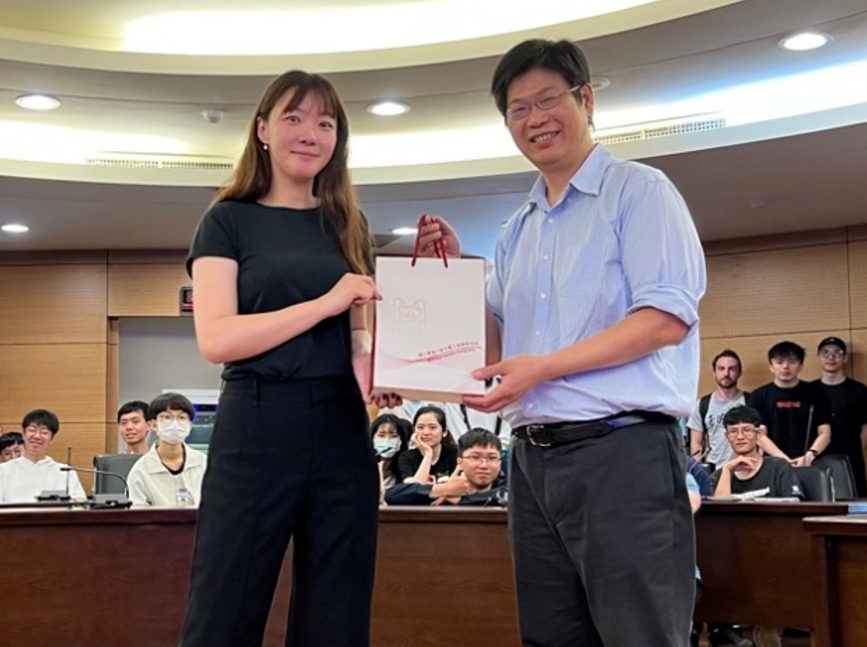
|
|
Prof. Yu-Chieh Cheng (Left) and Prof. Jiun-Haw Lee (Right)
|
|
|
May “GIPO Colloquium” Highlights
|
|
Time:
|
2:20 pm, May 3 (Fri.), 2024
|
|
Speaker:
|
Prof. Huai-Ti Lin (Department of Bioengineering, Imperial College, London)
|
|
Topic:
|
What can we learn from animals?
|
|
|
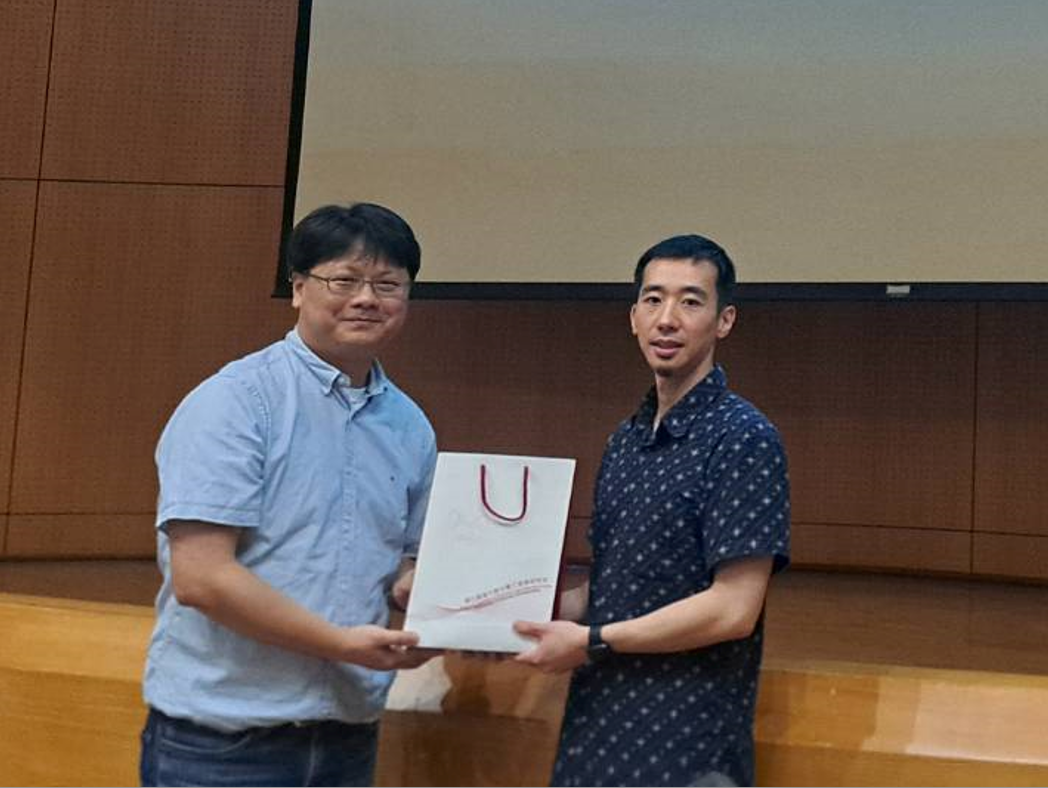
|
|
Prof. Huai-Ti Lin (Right) and Prof. Hsiang-Chieh Lee (Left)
|
|
|
Time:
|
2:20 pm, May 10 (Fri.), 2024
|
|
Speaker:
|
Prof. Rong-Ping Liu (Department of Photonics, Feng Chia University)
|
|
Topic:
|
Three-Dimensional Imaging by Optical Scanning Holography
|
|
|
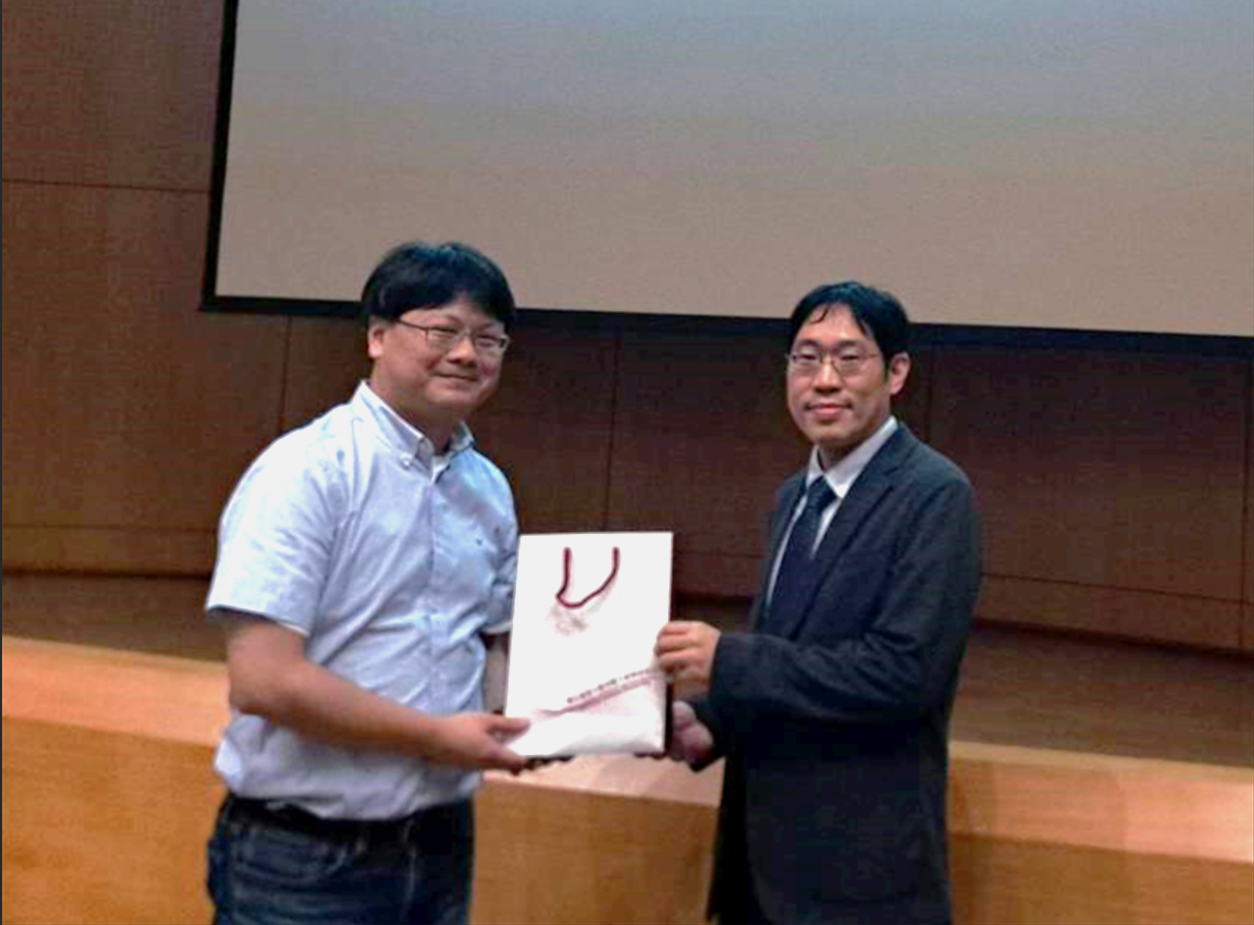
|
|
Prof. Rong-Ping Liu (Right) and Prof. Hsiang-Chieh Lee (Left)
|
|
|
Time:
|
2:20 pm, May 17 (Fri.), 2024
|
|
Speaker:
|
General Manager Yung-Peng Chang (Taiwan Color Optics Inc.)
|
|
Topic:
|
New Opportunities for AI in the Photonics Industry
|
|
|
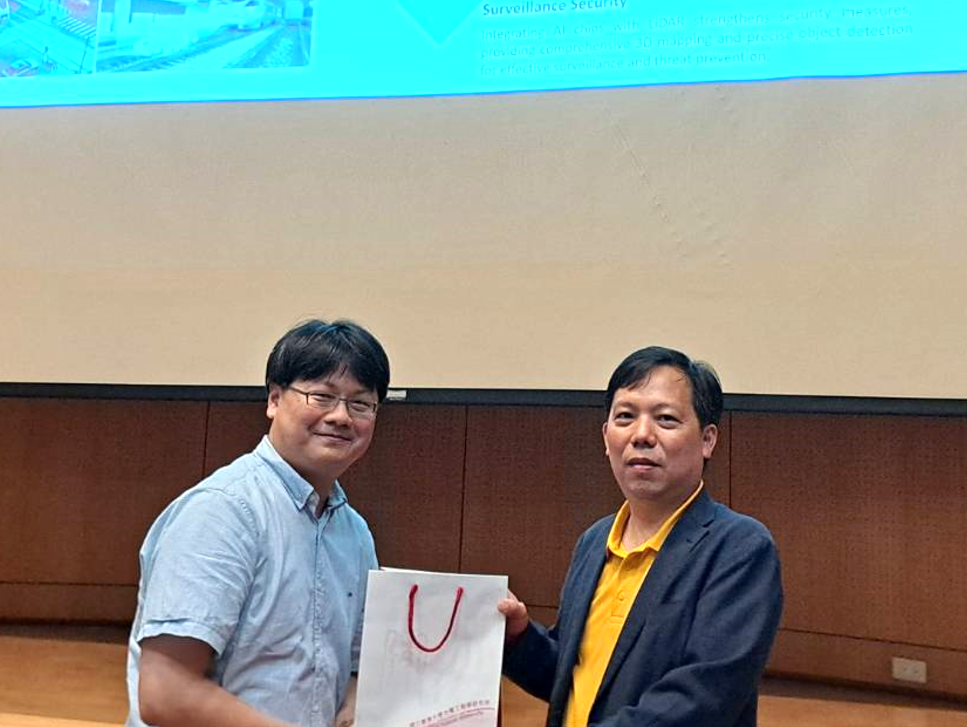
|
|
General Manager Yung-Peng Chang (Right) and Prof. Hsiang-Chieh Lee (Left)
|
|
|
Time:
|
2:20 pm, May 24 (Fri.), 2024
|
|
Speaker:
|
Department Manager Li-Ruei Chen (EUVL Division, TSMC)
|
|
Topic:
|
Extreme Ultraviolet: Light up the Bright Future of the World
|
|
|
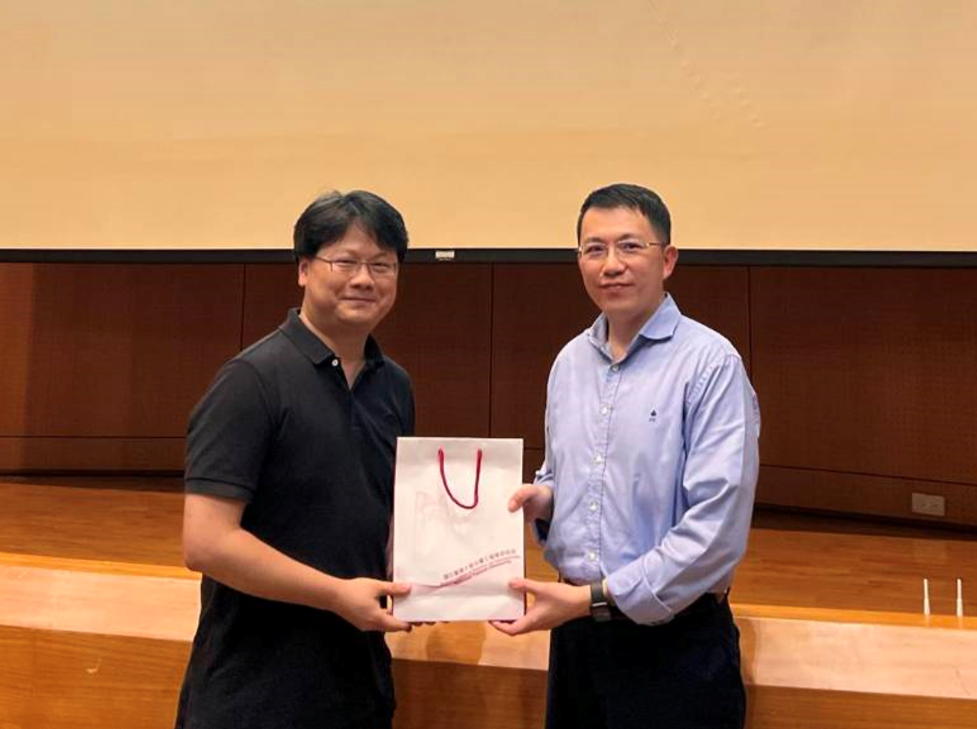
|
|
Department Manager Li-Ruei Chen (Right) and Prof. Hsiang-Chieh Lee (Left)
|
|
|
Time:
|
2:20 pm, May 31 (Fri.), 2024
|
|
Speaker:
|
Vice General Manager Yong-He Chen (Browave Corporation)
|
|
Topic:
|
Trends in Optical Packaging Technology and Silicon Photonics
|
|
|
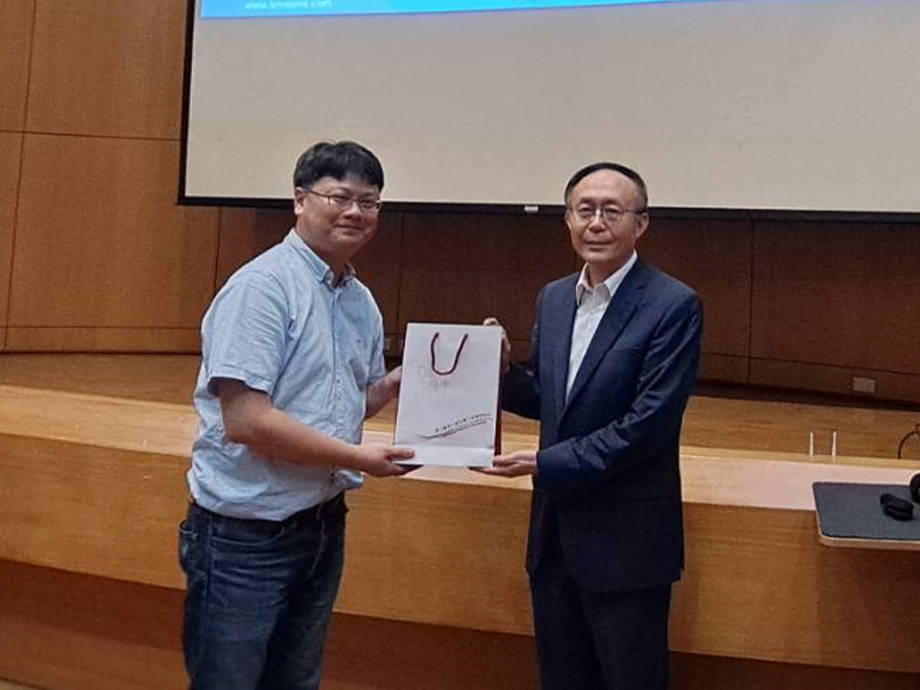
|
|
Vice General Manager Yong-He Chen (Right) and Prof. Hsiang-Chieh Lee (Left)
|
|
|
~ GIPO Badminton Competition 2024 ~
(March 23, 2024, NTU Gymnasium)
By Li-Wei Sun, the President of GIPO Student Association
On March 23rd of this semester, the GIPO Badminton Competition 2024 was held by the Graduate Institute of Photonics and Optoelectronics (GIPO), of which the aim was to give the participants a chance to exercise and some others an opportunity to display their personal skills. The competition format adopted a group round-robin elimination ladder in a best-of-three matches style. The overall preparation work for the tournament, from the venue preparation to general competition planning, was conducted by the GIPO Student Association, and the enthusiasm of the students participating became the greatest motivation force. Although some complications arose due to the venue limitations and the number of participants, all participants were understanding and cooperated where needed. On the day of the competition,
the Chairman of GIPO Prof. Yuh-Renn Wu
also personally participated in the competition, and contributed many exciting moments.
On the day of the competition, the morning opened with the men's and women's singles matches. With the round-robin competition format, each player had their opportunity to compete and contest their skills against different opponents. Under the watchful referee of the competition staff, the matches proceeded smoothly. The remarkable performances of the players contributed much excitement and passion to the atmosphere. The performance of Chairman Wu was particularly impressive, attesting to the old proverb "time sharpens skill and experience much like it sharpens the taste of ginger." After intense competition, finalists for both the men's and the women's competition were determined. The women's final match was definitely a highlight for the competition, while in the men's category, the advancement of Chairman Wu to the semi-finals added much excitement to the competition.
|
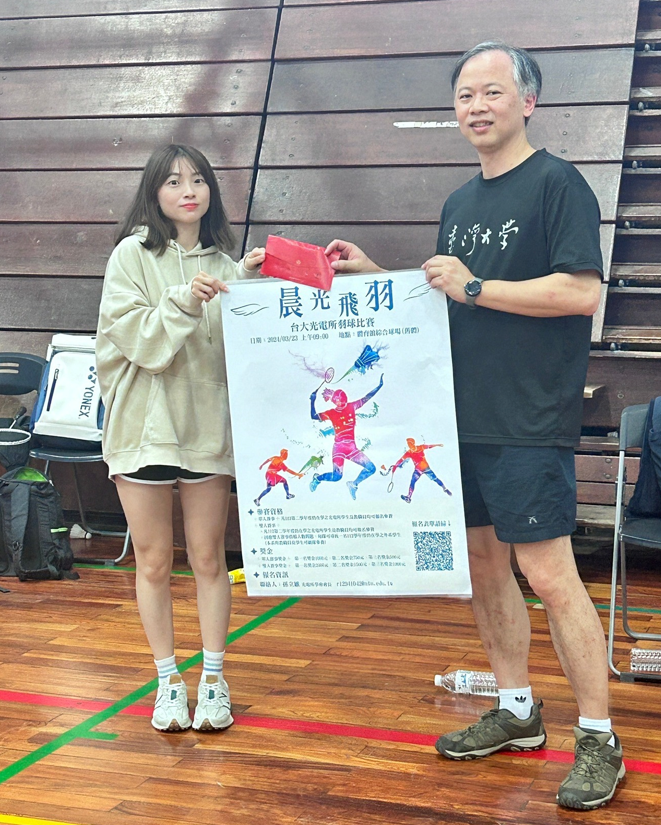 |
 |
|
Fig. 1. Women's singles champion Tzu-Hsuan Chang (Left) and Chairman Yuh-Renn Wu (Right) |
Fig. 2. Chairman Yuh-Renn Wu (Left) and Prof. Jiun-Lang Huang (Right) |
After lunch were the doubles matches and the group matches. The doubles matches tested the teamwork of each pair participants, and to be sure, all participants were highly skilled. After fierce competitions, the doubles competition also came to the semifinals. Although some minor accidents occurred along the way, fortunately everything smoothed out in the end. The group matches conducted with each individual lab registering as group participants, also had a few highlights.
Then, came the end of the competition, the exciting finals for the doubles competitions and the group competitions. Some particularly memorable moments were the Tzu-Hsuan Chang's mixed doubles final, Chairman Wu's men's doubles final, and Shu-Han Wu's and Sih-An Chen's men's singles final. The competitors were undaunting and unyielding, elevating the competition atmosphere to the peak.
|
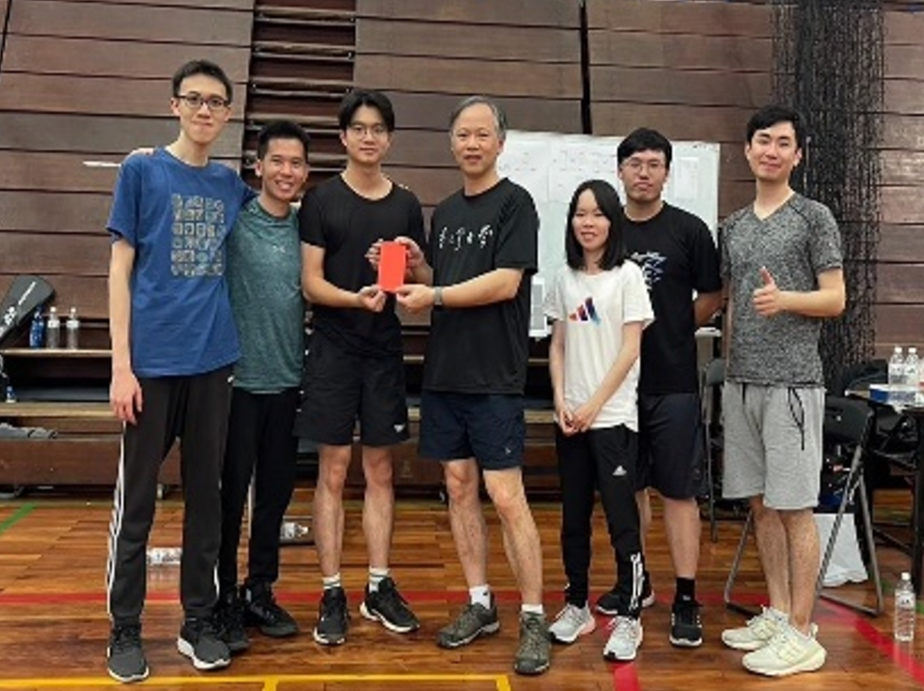 |
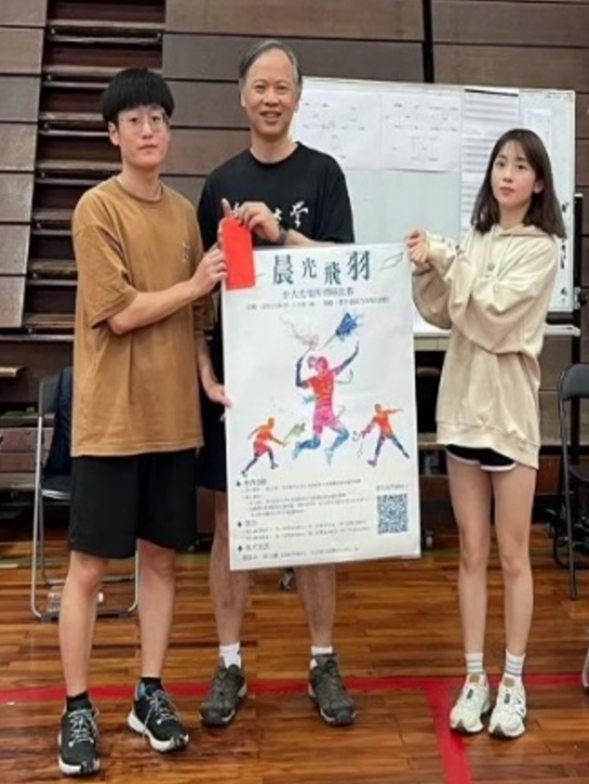 |
|
Fig. 3. Group matches champion Team Electron-Hole Pair and Chairman Yuh-Renn Wu (Middle) |
Fig. 4. Mixed doubles champions Ding-Ze Huang (Left), Tzu-Hsuan Chang (Right) and Chairman Yuh-Renn Wu (Middle) |
|
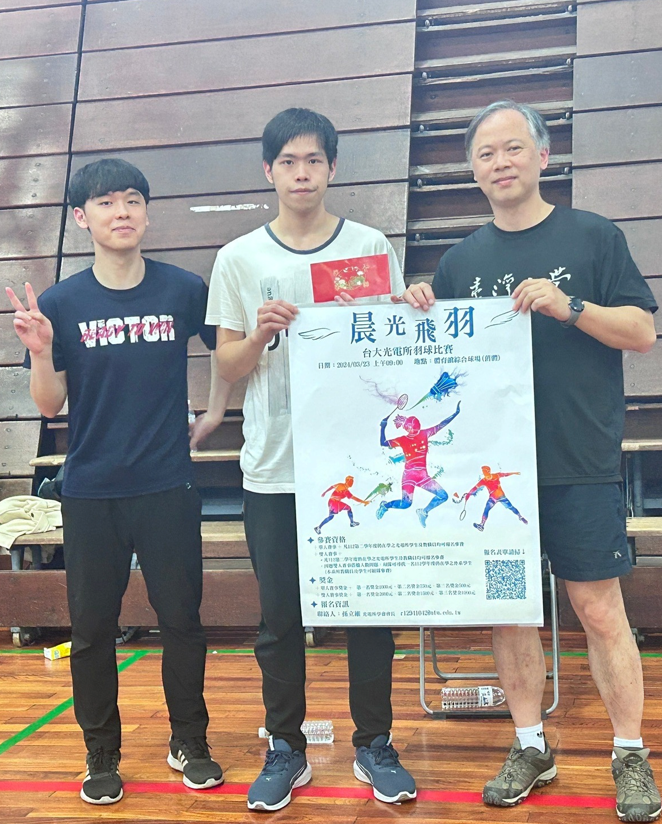 |
 |
|
Fig. 5. Men's doubles runners-up Sih-An Chen (Left), Yuan-Chao Wang (Middle) and Chairman Yuh-Renn Wu (Right) |
Fig. 6. Men's singles champion Sih-An Chen (Left) and Chairman Yuh-Renn Wu (Right) |
At the end of the competition, Chairman Wu held the award ceremony. The winners were awarded with rounds and rounds of applause, bringing a closing to this event.
|
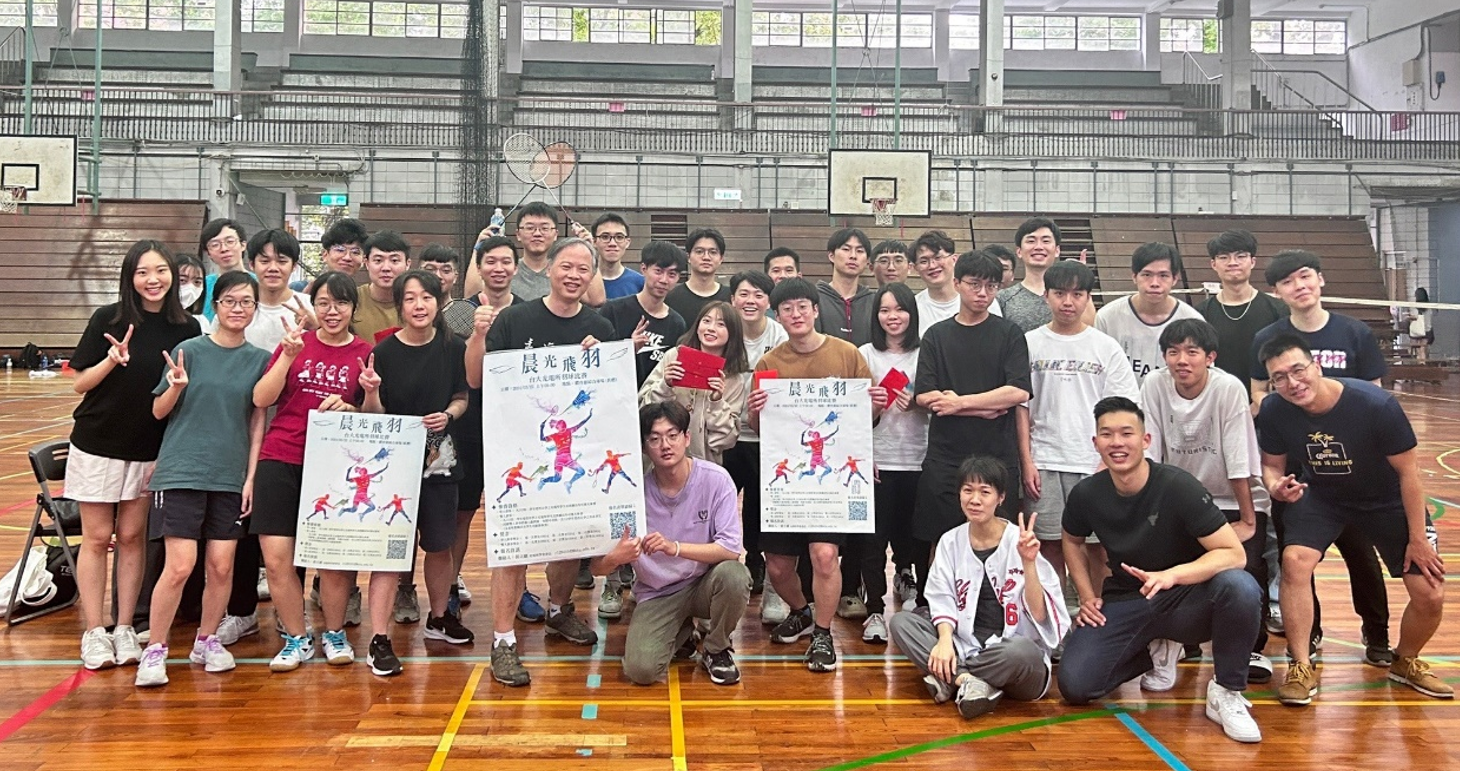 |
|
Fig. 7. Group photo of all participants |
|
|
|
|

|
|

|
|
| |
|
|

|
|
Touch Taiwan International Display Exhibition 2024 -
Forward-looking Display Technology Interdisciplinary Training Program
(April 24-26, 2024, Taipei Nangang Exhibition Center)
By Prof. Hoang-Yan Lin
This year is the fourth year of the Ministry of Education's (MOE) "Forward-looking Display Technology Interdisciplinary Training Program" since it began in 2021, and the third time that the MOE actively participated in the Touch Taiwan International Display Exhibition, actively organized by the Taiwan Display Union Association (TDUA), from April 24 to 26 this year (2024). This exhibition is Taiwan's largest event in the electronic technology industry in the first semester of the year, attracting 312 companies from over 10 countries, utilizing a total of 882 booths with 31890 participants from both in and out of the country. The exhibition had close to 30 topical forums, inviting up to 159 speakers and attracting 2,781 participants. This year, the MOE's third time participation in the "Forward-looking Display Technology Interdisciplinary Training Program" achieved both the goal of showcasing project outcomes and the goal of promoting the industry-academia linkages.
The MOE's "Forward-looking Display Technology Interdisciplinary Training Program" aimed to showcase the promotional results and achievements in display technology using the Digital Course Modules and the Smart Campus Demonstration Fields. During the event, the MOE planned two showcases in the "Innovative Academia" exhibition area, the "Immersive Smart Area" and "Academic Digital Teaching Materials," where the visitors were invited to engage with a variety of the most advanced research results in display technology.
The opening ceremony was held at 10:00 AM on the first day in the Light Corridor outside the exhibition hall, which Vice President Lai personally attended and delivered a speech and attended the exhibition. Prof. Huang-Yan Lin, the chief director of the program at MOE, was invited to attend the opening ceremony, and used 5G technology to transmit a photo of Vice President Lai to an electronic whiteboard in the MOE's exhibition booth for display. At the end of the tour, Vice President Lai was invited to sign a signature for the MOE project team (Fig. 1). The Executive Secretary Hung-Chun Shen of the National Science and Technology Council's Technology Office, along with MOE officials and project leaders, also took a group photo with Vice President Lai's signed photo (Fig. 2), marking the end of tour and the beginning of three exciting days of exhibitions!
|
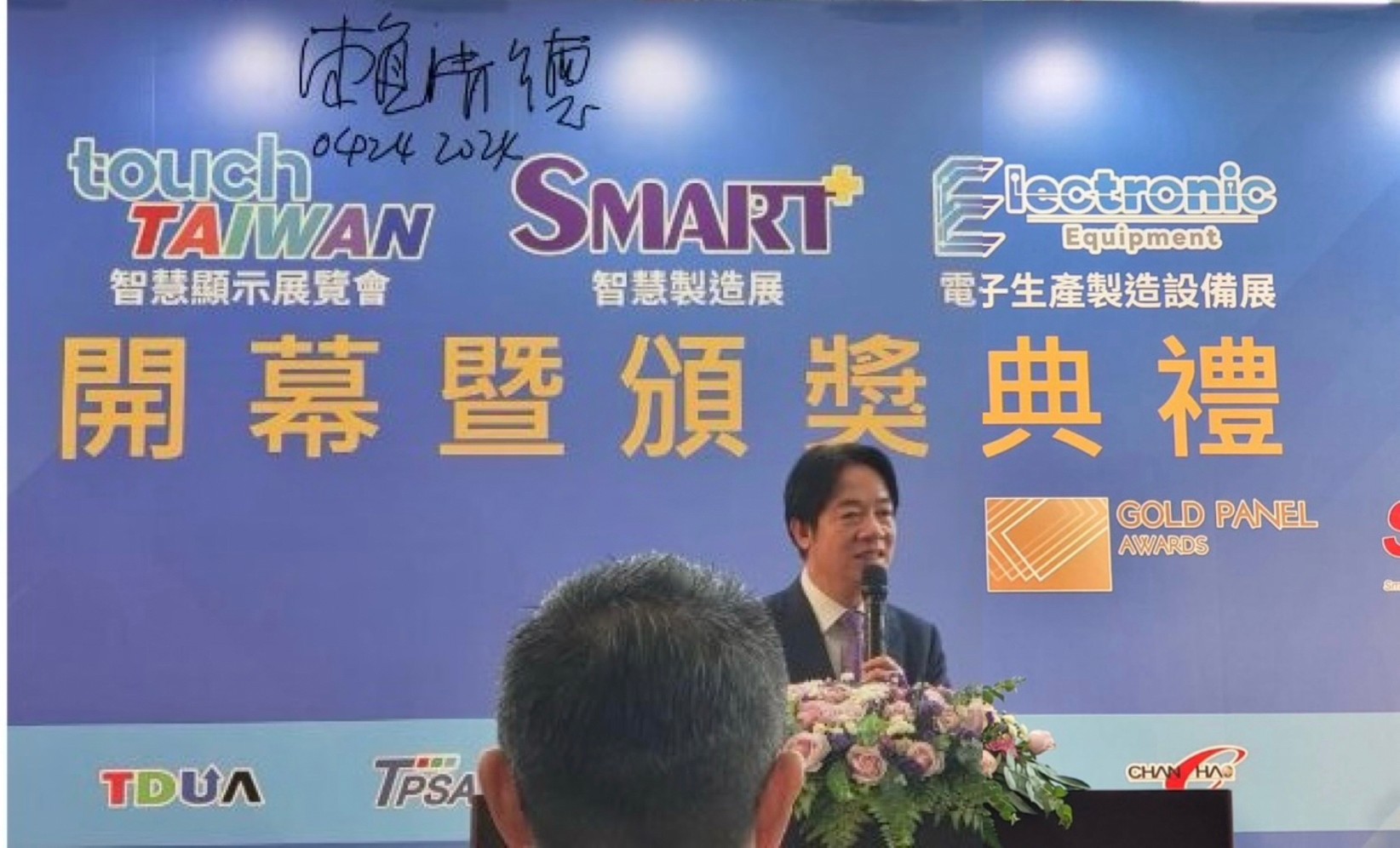 |
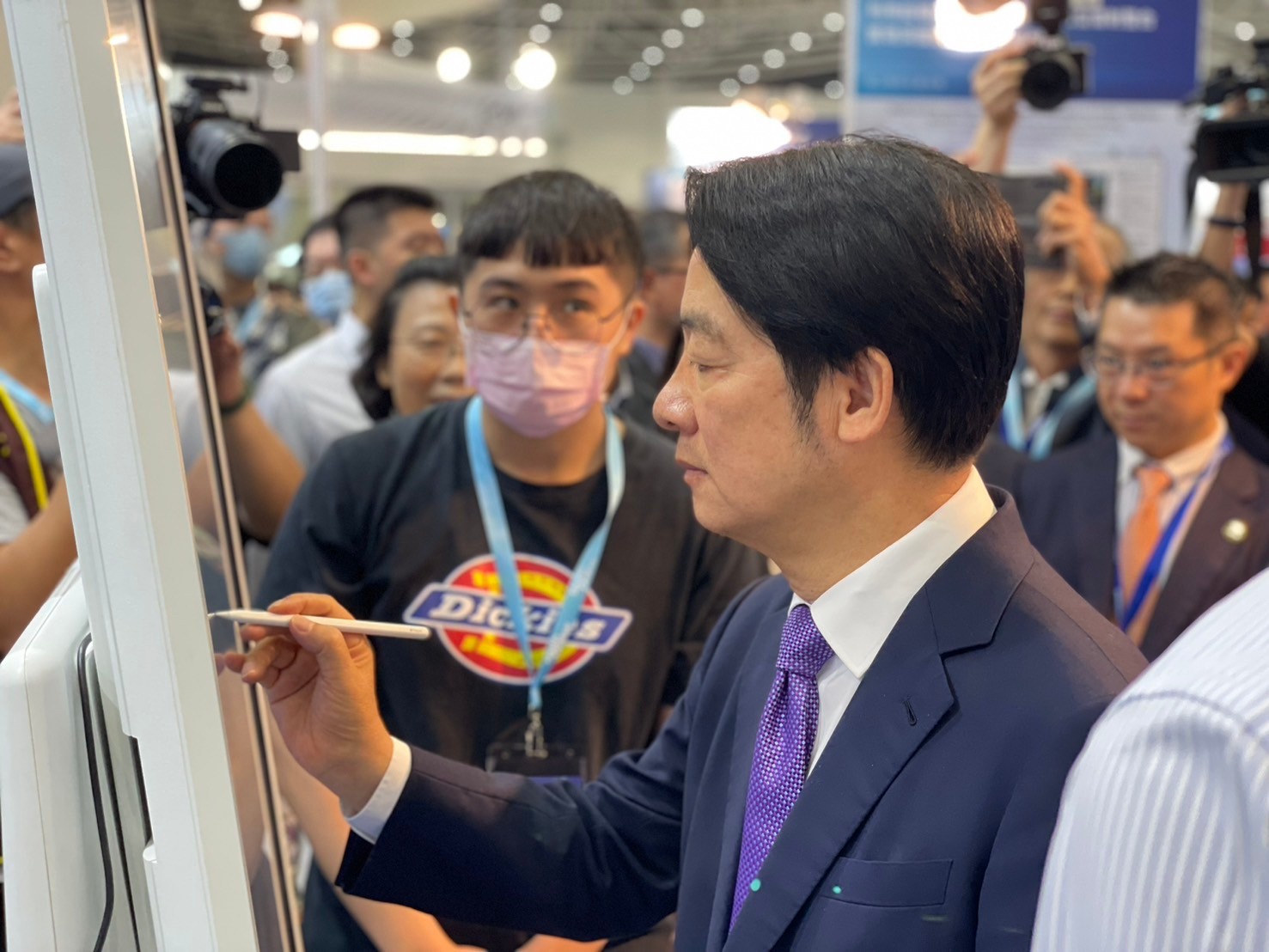 |
|
Fig. 1. Vice President Lai giving his signature at the MOE demonstration booth |
|
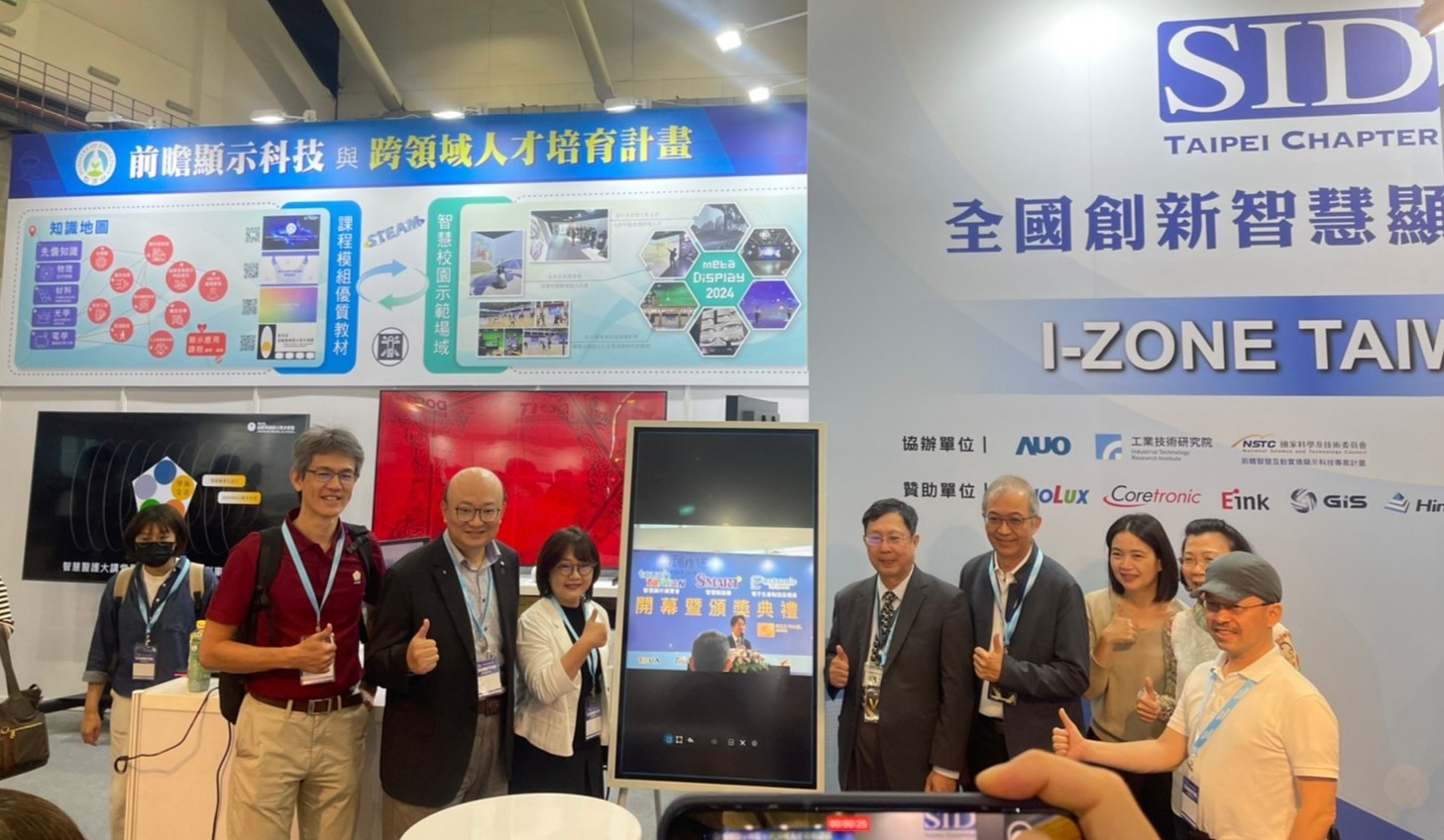 |
|
Fig. 2. Executive Secretary Hung-Chun Shen (Technology Office, National Science and Technology Council) (Right 5th), Prof. Huang-Yan Lin (National Taiwan University) (Right 4th), Assoc. Prof. Hsiao-Mei Hsieh (National Taiwan University) (Right 3rd), Prof. Yu-Hui Chen (National Taiwan University) (Right 2nd), Vice Principal Yi-Ping Hung (Taipei National University of the Arts) (Right 1st), Assoc. Prof. Yao-Hua Su (National Taiwan Normal University) (Left 4th), Dean Wen-Chung Kao (National Taiwan Normal University) (Left 3rd), and Professor Tsang-Hai Huang (National Cheng Kung University) (Left 2nd) |
The MOE's "Forward-looking Display Technology and Interdisciplinary Training Program" began four years ago, with participating teams including faculties and students across more than 20 universities and colleges. This showcase in this exhibition was placed adjacent to the Innovative Smart Display Zone (I-Zone) (Fig. 2). The choice of exhibition location also showed the MOE's intention and ambition to strengthen the training of new talents, the teaching-research integration, and establish direct contact between potential collaboration partners.
The first showcase in the "Immersive Smart Area" utilized a VR simulation system developed by the project. Through the VR headsets, audiances were led into NTU's Future Exhibition Venue, the "Experimental Theater," to experience the two immersive works the "Dream within a Dream" and the "Animal Carnival." The team from NTNU focused on the integration of art and technology. Wearing the VR headsets, it was as though the visitors are taken to the Light Corridor of NTNU's Art Museum. The visitors could experience the experimental interactive works the "Frame of Choices" created by Prof. Yan-Rong Chang's team and AI assistance, and the somatosensory interactive work with Hakka elements "Rice Dragon 360" by Prof. You-Ting Hsueh's team, representing each grain of rice with digital dynamic particles (Figure 3). Additionally, NCKU used panoramic photography and dynamic 3D capture combined with green screen technology to demonstrate applications of smart display technology in the physical fitness context such as basketball, volleyball, and strength training as they would be conducted in the gymnasium, expanding visitors' creativity in using VR in education settings. Also, electronic paper, one of the most important next-generation display technologies, was presented by NTNU in collaboration with the industry (Fig. 4), displaying a series of paintings. What was also most impressive was NTNU's temperature control chips and image engines, giving flat grayscale images depths and layers and making full-color images appear closer to how they would appear in reality, with impressive fluency in the video playback.
|
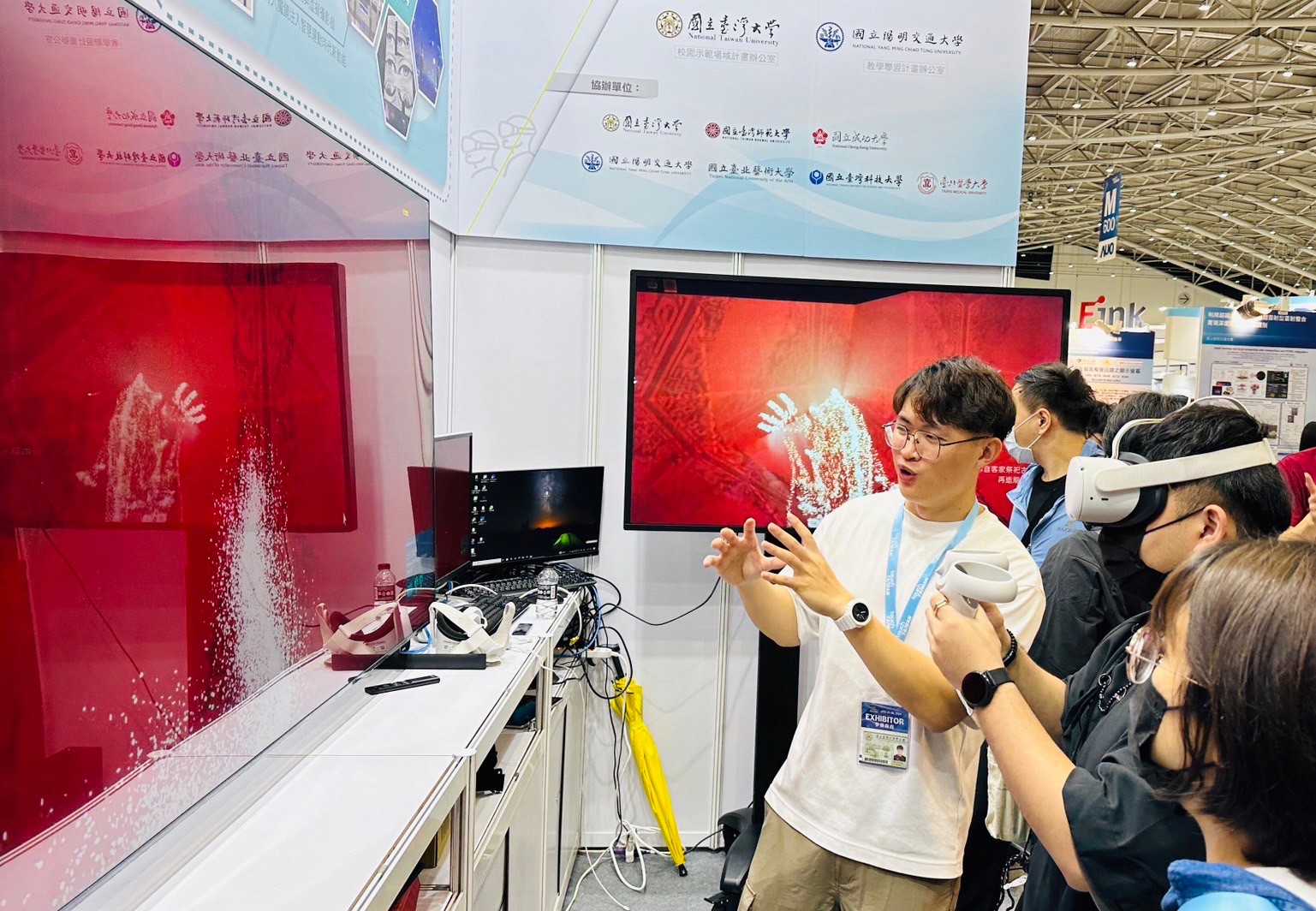 |
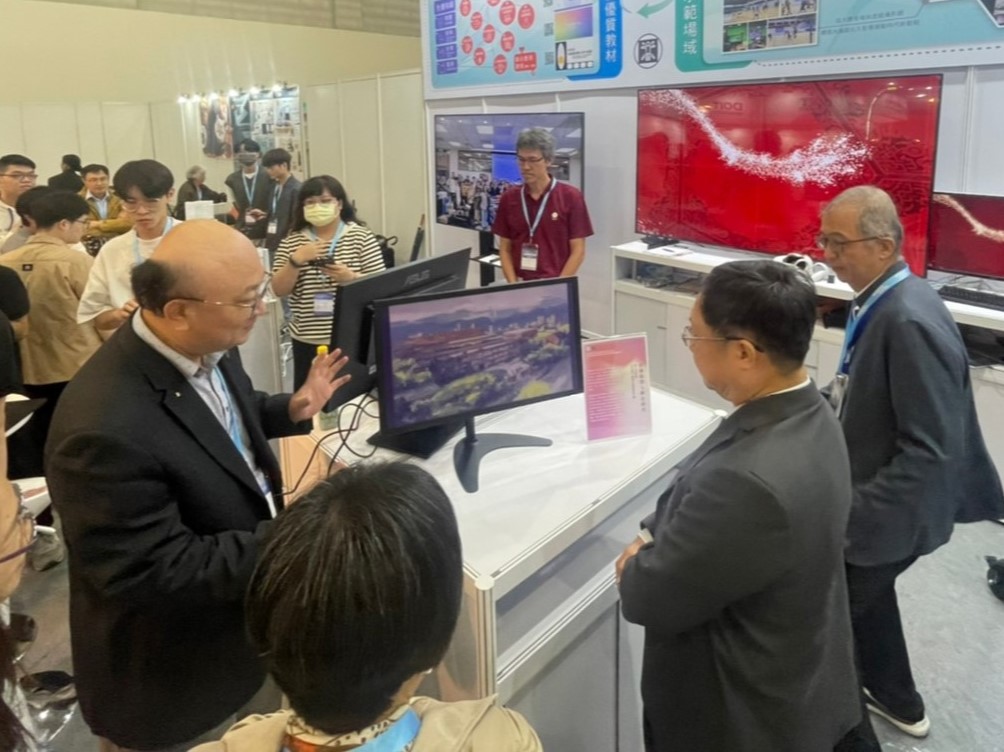 |
|
Fig. 3. "Rice Dragon 360" by Prof. You-Ting Hsueh's team |
Fig. 4. Dean Wen-Chung Kao (NTNU) (Left 1st) introducing the Electronic Paper display to Executive Secretary Hung-Chun Shen (Technology Office, NSTC) (Right 2nd) and the MOE officials and Prof. Hoang-Yan Lin (Project Chief Office) (Right 1st) |
The second demonstration, the "Academic Digital Teaching Materials," was presented by the Teaching Alliance teams from National Yang Ming Chiao Tung University, National Taiwan University of Science and Technology, National Cheng Kung University, and Taipei Medical University. The alliance developed a wide range of digital teaching materials based on the display technology roadmap, encouraging the idea of "mixed-learning and novelty-in-the-classroom" to assist independent learning in students, creating more interaction chances for the teaching-learning correlation (Fig. 5). The Yang Ming Chiao Tung University Alliance focused on developing related courses and modules in smart display and sensor technology, and the training of new talents in AR and VR imaging. The VR sets in the demonstration provided an immersive experience. The National Taiwan University of Science and Technology Alliance focused on audiovisual and multi-screen interaction, demonstrating a 3D stereoscopic display showing an optical illusion effect through multi-screen splicing, producing an immersive 3D experience. Also SparkAR was used to integrate elements of fun in learning the language of English and Taiwanese, and a documentary on light and shadow art exhibitions. The National Cheng Kung University Alliance focused on the AR/VR-IoT integration applications, with the "AR/VR Environment Sensing IoT Experiment" course module, bringing into the curriculum real world applications to help students understand how to combine AR/VR with IoT (Fig. 6). The Taipei Medical University Alliance focused on supportive medical technology, medical education and mental health, demonstrating VR lessons (defibrillation procedures, concentration activities, and spatial cognition) and MR lessons (meridian massage and human anatomy).
|
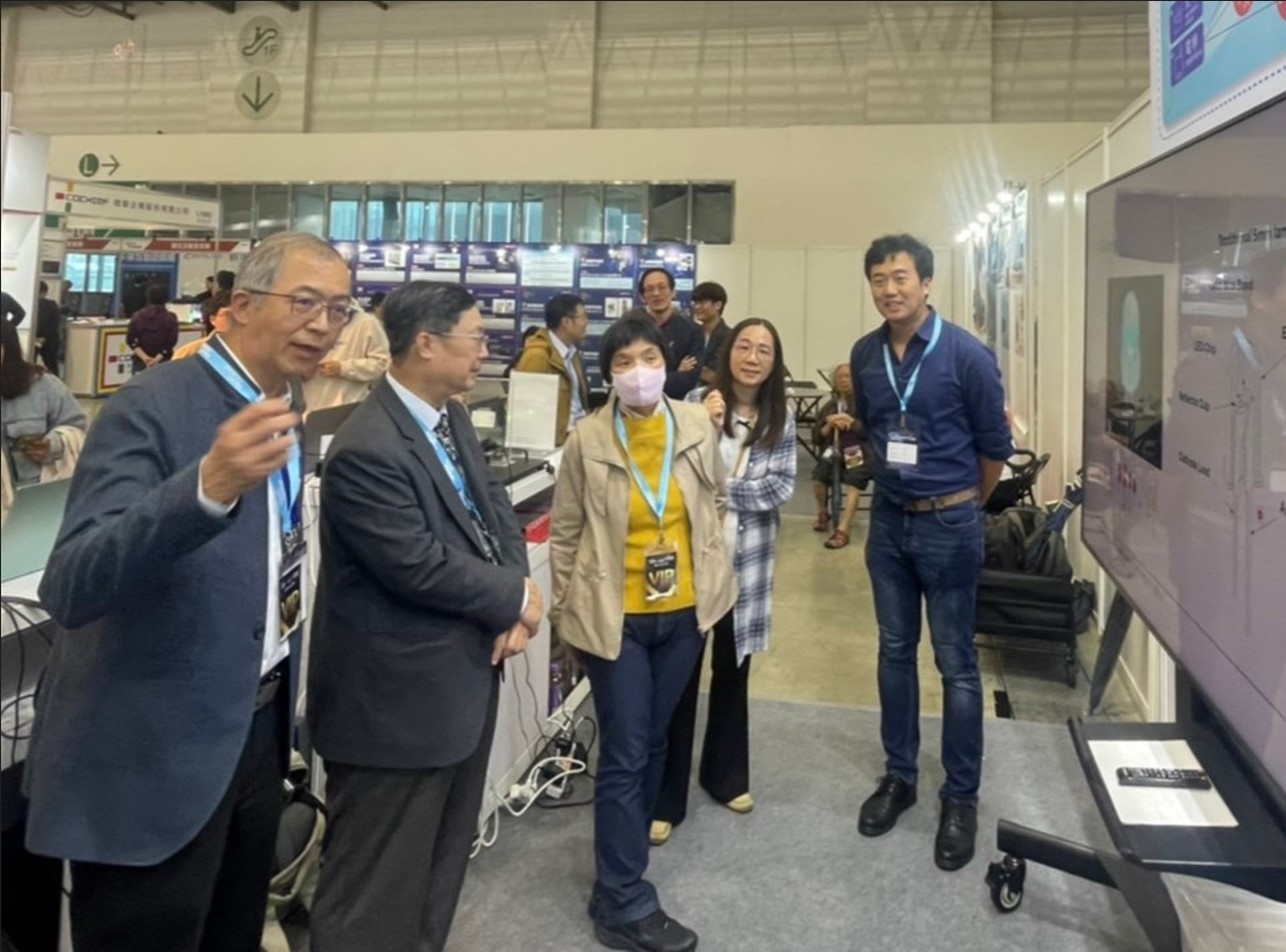 |
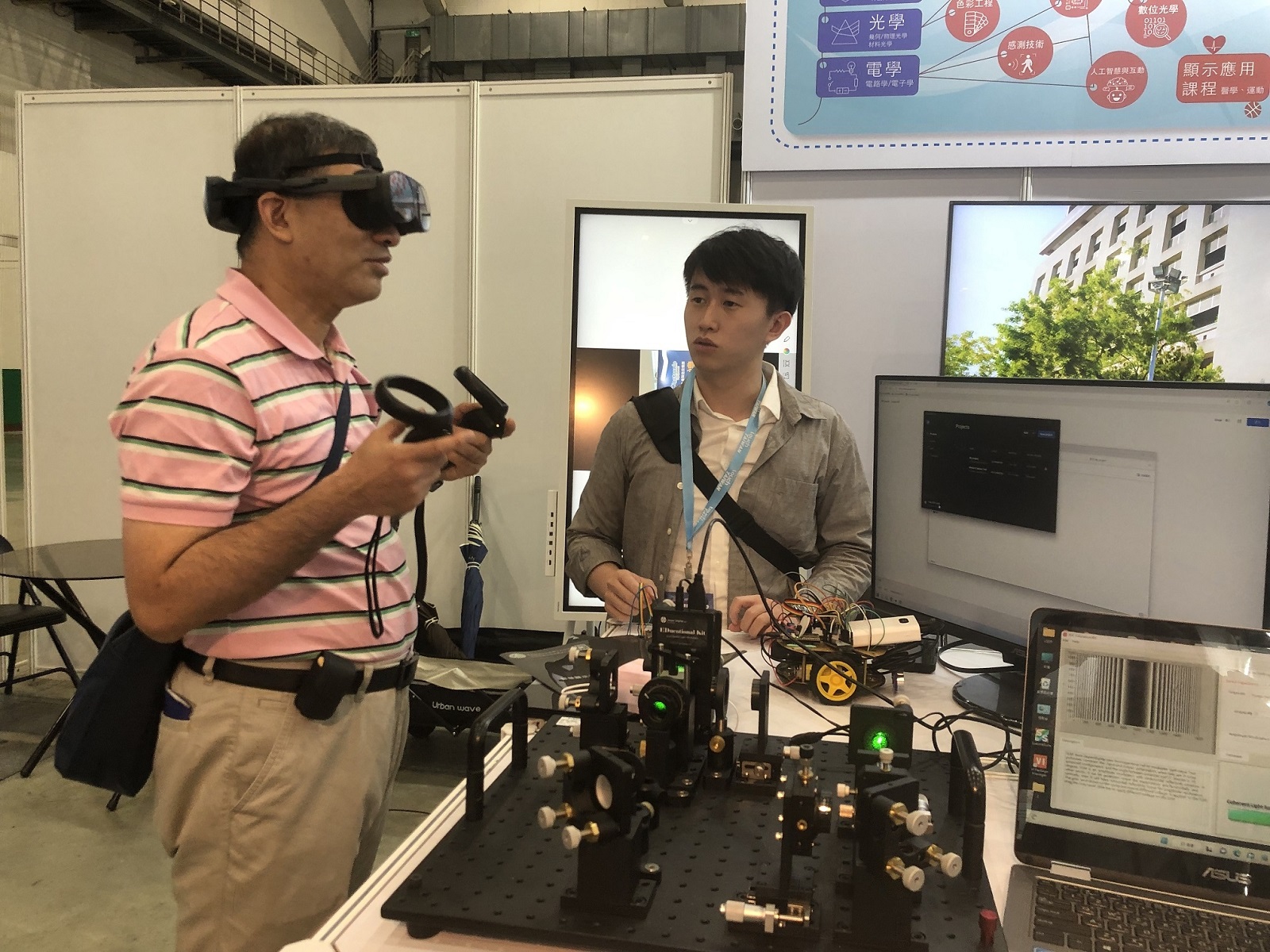 |
|
Fig. 5. Assoc. Prof. Cheng-Shan Yang (NTNU) (Right 1st) briefing project results to Executive Secretary Hung-Chun Shen (Technology Office, NSTC) (Left 2nd), Senior Manager Man-Chi Lan (MOE) (Left 3rd) and Prof. Hoang-Yan Lin (Project Chief Office) (Left 1st) |
Fig. 6. VR Remote Car by NCKU, an AR/VR interactive experience |
At the Touch Taiwan International Display Exhibition 2024, the MOE demonstrated a series of project achievements, highlighting the importance of the "Forward-looking Display Technology and Interdisciplinary Training Program" executed over the past four years. This exhibition was not only a demonstration of project results, but also a demonstration of the importance of MOE's contributions to Taiwan's display technology industry. During the exhibition, the MOE "Forward-looking Display Technology and Interdisciplinary Training Program" team, other than the aforementioned achievements, also promoted other sub-projects related to display ergonomics courses, digital optics, and project implementation competitions. The project team hopes that this year's (the fourth year) project competition will advance the "Forward-looking Display Technology and Interdisciplinary Training Program" further, from the beginning course development to the field implementation at the very end.
|
|
|
|

|
|

|
|
| |
|
|

|
|
Ultrahigh Resolution Microdisplay Technologies Based on Color Conversion Technique
Professor Ching-Fuh Lin
Graduate Institute of Photonics and Optoelectronics, National Taiwan University
Our team has successfully integrated polymer color conversion composite materials with oxide nanoparticles, reducing the aspect ratio of their pixel structures, mitigating color crosstalk effects, and enhancing the quantum efficiency (QY) and conversion efficiency (CE) of the color conversion layer. For a color conversion layer thickness of 3 µm (w/ NPs), the QY and CE for green are 86.3% and 86.0%, respectively, while for red, they are 78.8% and 78.5%, respectively. At a thickness of 2 µm (w/ NPs), the QY and CE for green are 78.9% and 72.3%, respectively, and for red, they are 66.3% and 62.0%, respectively. Additionally, we conducted tests on the color conversion layer for water and oxygen resistance and temperature stability. After 240 hours of testing at 60°C and 90% relative humidity, the conversion efficiency of both green and red color conversion layers with added nanoparticles decreased by less than 1%, demonstrating their durability under normal environmental conditions.
The individual array has been miniaturized to a size of 1.4 μm, and the thickness has been reduced to 2 μm. This provides a resolution of 11548 PPI in monochrome and 5774 PPI in full color, as shown in Figure 1. Further optimization of Micro-LED chips and quantum well characteristics, along with the development of integrated circuitry for display driving, will enable real-time control of Micro-LED display images, leading to the realization of ultra-high-resolution full-color conversion microdisplays in the future.
|

|
|
Fig. 1. (a) The resolution of 11548 PPI in monochrome of red and green pixel arrays. (b) The resolution of 5774 PPI in monochrome red and green pixel arrays and full color pixel arrays.
|
Research highlights of Nanosheet/Nanowire GeSi
Professor Chee-Wee Liu
Graduate Institute of Photonics and Optoelectronics, National Taiwan University
Nanosheet/Nanowire gate-all-around field effect transistors (GAAFETs) are used to replace FinFETs due to their good electrostatics and short channel control. Moreover, to enhance the drive current and to improve overall transistor density, channel stacking is done at the same footprint. In alignment with this trajectory, our research group has also contributed significantly by increasing the number of stacked channels. Specifically, we have successfully showcased the functionality of 16 stacked Ge0.95Si0.05 nanowires (Figure 1(a)), achieving a groundbreaking drive current of 9400μA/μm per footprint at VOV=VDS=0.5V [1]. Moreover, to further enhance transistor performance, we have implemented a novel two-step wet etching process, leading to the demonstration of 12 stacked Ge0.95Si0.05 nanowires (Figure 1(b)) without parasitic channels [1]. This resulted in minimized transistor leakage and subthreshold swing. We have also achieved the record drive current i.e. 9200μA/μm per footprint and 360μA per stack, respectively, at VOV=VDS=0.5V for 8 stacked Ge0.95Si0.05 nanosheets (Figure 1(c)) (WCH=120nm) with extremely
high-k
Hf0.2Zr0.8O2 [2]. Furthermore, our group stands the pioneer in showcasing the first stacked Ge0.98Si0.02 Nanosheet FeFET (Figure 2 (a, b) ) at the record low write voltage of 2V and endurance > 1E11 cycles [3].
|

|
|
Figure 1 (a) 16 stacked Ge0.95Si0.05 nanowires [1]. (b) 12 stacked Ge0.95Si0.05 nanowires without parasitic channels [1]. (c) 8 stacked Ge0.95Si0.05 nanosheets [2] (©2023 JSAP).
|
|

|
|
Figure 2 (a, b) 2 stacked Ge0.98Si0.02 NS GAA n-FeFETs [3] (©2023 JSAP).
|
Reference:
[1] Yu-Rui Chen et al. Communications Engineering, 2, 77, pp. 1-9, 2023.
[2] Yi-Chun Liu et al. in IEEE Symposium on VLSI Technology and Circuits JUNE 11-16, 2023.
[3] Yu-Rui Chen et al. in IEEE Symposium on VLSI Technology and Circuits JUNE 11-16, 2023.
Structured NIR and Yellow-Orange Light Generation from
c(2) Nonlinear Photonic Crystals
Professor Lung-Han Peng
Graduate Institute of Photonics and Optoelectronics, National Taiwan University
Structured beams have been useful to some research fields, like quantum communication, super-resolution microscopy, and particle manipulation. Conventional ways of structured beams generation require liquid-crystal spatial light modulator (SLM) or q-plate which will complicate the whole optical layout thus limiting their application. In this study, we propose a nonlinear mode converter which will not only produce structured light, but also generate new frequency of light. Fig. 1(a) shows our structured NIR and visible mode converter design, in the parallel bi-grating part, the generated signal and idler will become structured. Then, these structured idler waves will be up-converted into visible light via second harmonic and sum frequency generation, and naturally, the up-converted visible light will also be structured. Our design shows another way to the structured beams generation which will be applicable to the UV band.
|
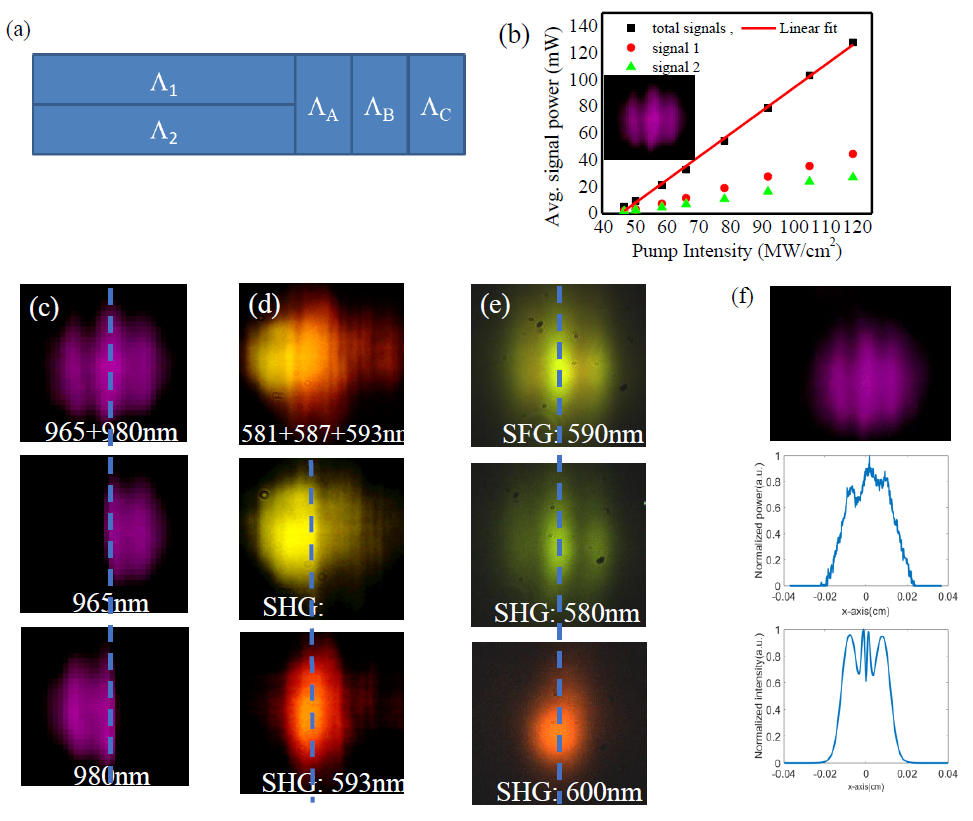
|
|
Fig. 1 (a) Design of nonlinear mode converter, where Λ1= 7.66 mm, Λ2= 7.68 mm, ΛA= 9.915 mm, ΛB= 10.188 mm and ΛC= 10.468 mm. (b) the output power of dual signal waves with respect to the pump intensity. Inset: the transverse mode of structured dual signal waves. (c) the transverse modes of dual signal, signal 1 and signal 2. (d) the transverse mode of the up-converted visible light (e) by adding additional grating, the structure mode of visible will become clear. (f) from top to bottom are the transverse mode, experimental intensity profile and numerical mode simulation of the dual signal waves.
|
Broadband wavelength-swept Cr4+:YAG crystal fiber laser
Professor Sheng-Lung Huang
Graduate Institute of Photonics and Optoelectronics, National Taiwan University
We present a broadband wavelength-swept laser using a 16-μm-core-diameter Cr4+:YAG crystal fiber as the gain medium. The laser-diode-pumped crystal fiber laser has a threshold of only 102 mW due to the low propagation loss and high heat dissipation efficiency. The laser achieves a sweeping wavelength range of 134 nm, centered around 1425 nm, with a scanning speed of 163k nm/s. Notably, the cross-polarization-coupled excited state absorption of the signal wavelength constrained the long-wavelength lasing limit. This laser has the potential for swept source optical coherence tomography applications, providing an axial resolution of 11.4 μm.
|
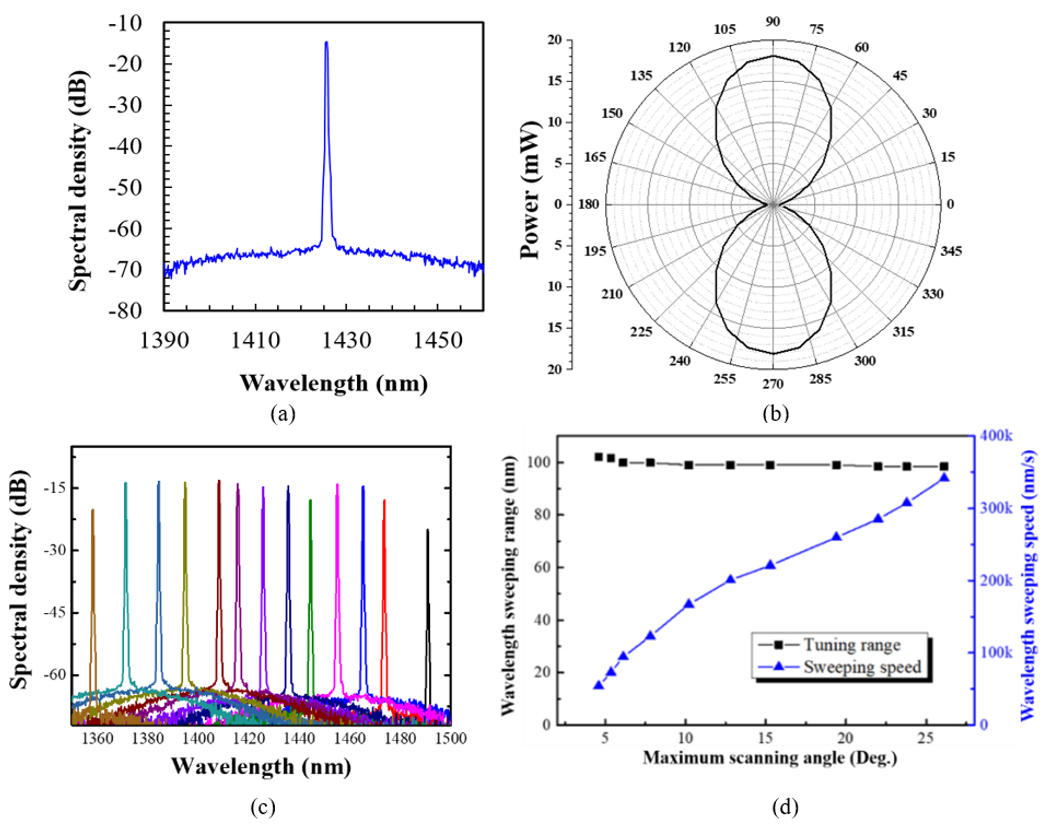
|
|
Fig. 1. The measured laser (a) instantaneous spectrum, (b) output polarization, and (c) tunable spectra from 1358 nm to 1491 nm. (d) Influence of wavelength sweep speed on the swept-laser wavelength range.
|
Reference:
Y. H. Li, Y. W. Lee, and S. L. Huang, "Broadband wavelength-swept Cr4+:YAG crystal fiber laser," Optics Express 31(20), pp. 32772–32782, 2023.
True-H&E Rapid Fresh Pathology Assisted with Mesoscale Nonlinear Optical Gigascope
Professor Chi-Kuang Sun
Graduate Institute of Photonics and Optoelectronics, National Taiwan University
Hematoxylin and Eosin (H&E)-based frozen section (FS) pathology is presently the global standard for intraoperative tumor assessment (ITA). Preparation of frozen section is labor intensive, which might consume up-to 30 minutes, and is susceptible to freezing artifacts. An FS-alternative technique is thus necessary, which is sectioning-free, artifact-free, fast, accurate, and reliably deployable without machine learning and/or additional interpretation training.
Our team develop a training-free true-H&E Rapid Fresh digital-Pathology (the-RFP) technique which is 4 times faster than the conventional preparation of frozen sections. The-RFP is assisted by a mesoscale Nonlinear Optical Gigascope (mNLOG) platform with a streamlined rapid artifact-compensated 2D large-field mosaic-stitching (rac2D-LMS) approach. A sub-6-minute True-H&E Rapid whole-mount-Soft-Tissue Staining (the-RSTS) protocol is introduced for soft/frangible fresh brain specimens. The mNLOG platform utilizes third harmonic generation (THG) and two-photon excitation fluorescence (TPEF) signals from H and E dyes, respectively, to yield the-RFP images.
Our team demonstrate the-RFP technique on fresh excised human brain specimens. The-RFP enables optically-sectioned high-resolution 2D scanning and digital display of a 1 cm2 area in <120 seconds with 3.6 Gigapixels at a sustained effective throughput of >700 M bits/sec, with zero post-acquisition data/image processing. Training-free blind tests considering 50 normal and tumor-specific brain specimens obtained from 8 participants reveal 100% match to the respective formalin-fixed paraffin-embedded (FFPE)-biopsy outcomes.
In conclusion, we provide a digital ITA solution: the-RFP, which is potentially a fast and reliable alternative to FS-pathology. With H&E-compatibility, the-RFP eliminates color- and morphology-specific additional interpretation training for a pathologist, and the-RFP-assessed specimen can reliably undergo FFPE-biopsy confirmation.
|
|
|
|

|
|

|
|
|
|
 |
|
 |
|
|
|
|